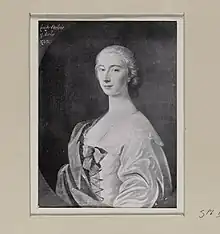
Margaret Ogilvy, Lady Ogilvy (1725 – 1757) was a Scottish Jacobite noblewoman.
Early life and family
She was born Margaret Johnstone, daughter of Sir James Johnstone, 3rd Baronet of Westerhall, and his wife Barbara Murray, whose brothers were involved in the Jacobite movement. Her many siblings included Barbara, James (later a lieutenant-colonel in the English army), William, George, and John.[1]
By 1745 she had eloped with David Ogilvy, son of John Ogilvy, 5th earl of Airlie.[2][3]
Jacobite rising of 1745
In 1745, Margaret accompanied her husband at the front of his regiment during the Jacobite uprising.[4] She was accused of inciting violence in Coupar Angus in October 1745: tearing down a poster of King George, and standing with a drawn sword to intimidate bailie James Hay into proclaiming that the Jacobite candidate was the rightful king.[5][6] She also accompanied the reserve force at the battle of Falkirk.[7]
After the Battle of Culloden in April 1746, Margaret was captured at Inverness and imprisoned in Edinburgh Castle. She escaped in November 1746.[8] Victorian accounts claim that she did this by trading clothes with her washerwoman and with the help of her sister Barbara Johnston.[9][10] Her husband had fled, via Norway and Sweden, to France, and Margaret joined him there.[7]
In 1747 she was among the Jacobite women to be criticised in the anti-Jacobite pamphlet The Female Rebel, which claimed, among other things, that she was only attracted to the Jacobite cause because she was charmed by the manners of the rebel Edward Stuart.[11]
Later life
Margaret and David's first child, Margaret, was born in Boulogne, France, in 1748,[12] at which point David was a lieutenant-general in the army of Louis XV.[7] This daughter married John Wedderburn.
The birth of their son David in Auchterhouse, Angus, in 1751 suggests that the Ogilvys were able to return to Scotland before David was pardoned by George III in 1778. Their son David was not considered to be of sound enough mind to inherit the title. He died in 1812.[13]
Their third child, Johanna, was born in 1755 or 6.[14] Margaret died in 1757.[7]
References
- ↑ Mosley, Charles, ed. (2003). Burke's Peerage, Baronetage & Knightage. Burke's Peerage. doi:10.5118/bpbk.2003. ISBN 978-0-9711966-2-9.
- ↑ Cockayne, G.E., ed. (2000). The Complete Peerage of England, Scotland, Ireland, Great Britain and the United Kingdom. Vol. I. p. 73.
- ↑ "The Orderly Book of Lord Ogilvy's Regiment IN THE ARMY OF PRINCE CHARLES EDWARD STUART 10 October, 1745, to 21 April, 1746". Journal of the Society for Army Historical Research. 2: i–52. 1923. ISSN 0037-9700. JSTOR 44221219.
- ↑ Craig, Maggie (1997). 'Damn' rebel bitches': the women of the '45. p. 20.
- ↑ "Spotlight: Jacobites - Lady of Swords". History Scotland. 2021-08-12. Retrieved 2023-12-01.
- ↑ Craig (1997), p. 19.
- 1 2 3 4 "Ogilvy, David, styled sixth earl of Airlie (1725–1803), Jacobite army officer". Oxford Dictionary of National Biography (online ed.). Oxford University Press. 2004. doi:10.1093/ref:odnb/20592. Retrieved 2023-12-01. (Subscription or UK public library membership required.)
- ↑ Martin, Carine (2015). "'Female Rebels': the female figure in anti-Jacobite propaganda". Living with Jacobitism, 1690–1788. p. 85.
- ↑ Millar, Alexander Hastie (1890). The Historical Castles and Mansions of Scotland. p. 34.
- ↑ Walford, Edward (1887). Chapters from Family Chests. Vol. I. pp. 104–5.
- ↑ Rebels, Female (1747). The female rebels: some remarkable incidents of the lives, characters, and families of the titular duke and dutchess of Perth [&c.]. Repr.
- ↑ Mosley, Charles, ed. (1999). Burke's Peerage and Baronetage. Vol. I (106th ed.). p. 45.
- ↑ Cockayne (2000), p. 75.
- ↑ Paul, James Balfour (1904). The Scots Peerage: founded on Wood's edition of Sir Robert Douglas's The Peerage of Scotland. Vol. I. p. 128.
External links
- A satirical print depicting Lady Ogilvy with sword in hand at the Battle of Culloden, along with Jean Murray and other Jacobite women by Charles Corbett at the British Museum.